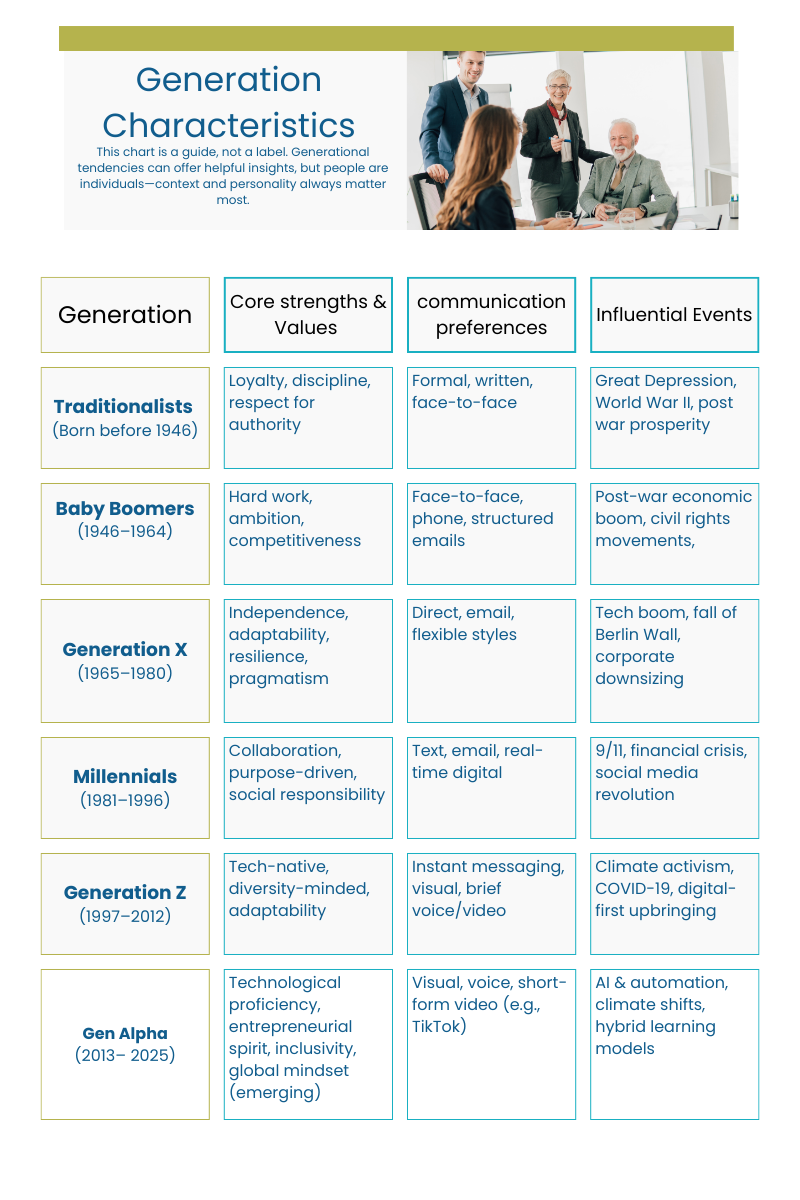Intergenerational working - How to make it your organisation’s superpower

Unlock the power of intergenerational working! Discover strategies to leverage age diversity strengths and make it your organisation’s secret weapon.
Recently, age diversity hit the headlines as Guernsey looks to include age discrimination in its anti-discrimination laws, following a series of tribunal cases. With this shift, it’s crucial that organisations reassess their approach to age diversity.
For the first time in history, today's workplaces span up to five generations—each bringing unique experiences and perspectives. Effectively managing this diversity can turn challenges and conflict into strengths, sparking innovation and resilience across teams.
The Current Landscape: Navigating Generational Diversity
Modern workplaces can now include up to five distinct generations:
-
Traditionalists (Born before 1946): Value loyalty, discipline, and respect for authority.
-
Baby Boomers (1946-1964): Known for a strong work ethic and commitment to their roles.
-
Generation X (1965-1980): Independent, adaptable, and often focused on achieving work-life balance.
-
Millennials (1981-1996): Tech-savvy, collaborative, and passionate about purpose-driven work.
-
Generation Z (1997-2012): Digital natives who value flexibility, diversity, and personal development.
Looking ahead, Generation Alpha (born after 2010) will also soon begin entering the workforce, bringing unique perspectives shaped by growing up in a tech-heavy, AI-driven world.
Current Approaches and Their Limitations
These diverse age groups can present challenges and potential conflict, especially when it comes to communication and expectations. Many organisations currently adopt one of two approaches to manage generational diversity:
-
Ignoring Differences: Treating all employees the same, without recognising generational distinctions, can lead to disengagement and a sense of being undervalued.
-
Overemphasis on Differences: Focusing too much on generational differences can create silos, fostering division rather than unity.
Dispelling Stereotypes
Each generation often tends to think they're superior to others, leading to negative stereotypes that hinder collaboration:
-
Younger Generations are often labelled as entitled or lacking work ethic.
-
Older Generations can be perceived as resistant to change or technologically inept.
These stereotypes can fuel misunderstanding, impacting team cohesion and morale. Let’s work to break down these misconceptions and focus on what makes each generation’s contributions valuable.
A Vision for Future Teams: Embracing Strengths and Shared Values
Instead of dwelling on challenges, picture a workplace where all generations communicate effectively, share knowledge, and respect each other’s perspectives. Teams are built on strengths, and innovation flourishes. This environment fosters motivation and engagement, and organisations thrive.
This ideal scenario isn’t just a dream—it’s entirely achievable with a few simple shifts in perspective.
What Can We Do?
-
Acknowledge Differences: Recognise the unique experiences each generation brings.
-
Focus on Strengths and Values: Shift the focus from differences to strengths, shared values, and mutual empathy.
-
Foster Mutual Learning: Encourage knowledge sharing across generations.

Charting Generational Characteristics
Understanding the historical, socio-cultural, and technological events that have shaped each generation is key. This awareness can foster empathy, allowing teams to appreciate diverse perspectives. For instance, the pandemic affected each generation
differently, shifting priorities and skill development.
This downloadable chart provides a snapshot of generational strengths, values, and communication preferences.
Intra-Generational Variations
It's essential to recognise that within each generation, there are significant variations. For example, within Generation Z, political alignments differ across gender, showing a shift toward political diversity. Recognising these nuances helps to prevent overgeneralisation and promotes a deeper, more individualised understanding of team members.
Emerging Workplace Trends:
-
Hybrid & Remote Work Preferences:
-
Younger generations (Gen Z & Millennials) prefer in-office collaboration for mentorship.
-
Older generations (Gen X & Boomers) value remote work for better work-life balance.
Organisations may need to offer flexible models to accommodate these varying needs.
-
-
AI and Automation:
-
Older workers might need upskilling to stay competitive in AI-driven roles.
-
Younger workers will thrive in AI environments, but soft skills (leadership, adaptability) will remain essential.
-
-
Universal Workplace Aspirations: Despite generational differences, employees across all age groups share key desires:
-
Meaning and Purpose: Work that contributes to the greater good.
-
Recognition and Respect: Being valued for contributions.
-
Opportunities for Growth: Ongoing learning and career development.
-
By fulfilling these shared needs, organisations can shift away from polarising approaches and create policies that benefit everyone.
Strategies to Leverage Intergenerational Strengths:
To transform generational diversity into a superpower, organisations should consider:
-
Personal Development Opportunities: Provide training tailored to different learning styles and career stages.
-
Intergenerational Mentoring: Encourage mentorship programmes where knowledge flows both ways.
-
Individualised Approaches: Move beyond stereotypes and recognise individual strengths.
-
Merit-Based Advancement: Focus on skills, performance, and potential instead of tenure.
Transforming Challenges into Organisational Superpowers
By proactively addressing generational dynamics, organisations can:
-
Enhance Innovation: Diverse perspectives lead to creative solutions.
-
Boost Employee Engagement: An inclusive culture improves morale and commitment.
-
Strengthen Talent Retention: Growth and recognition opportunities reduce turnover.
Conclusion
Embracing intergenerational working isn’t about ignoring or merely managing differences—it’s about leveraging them. By recognising and respecting each generation’s unique contributions, and focusing on shared values, organisations can turn potential challenges into powerful strengths. In doing so, intergenerational working can become your organisation’s superpower.
Categories: : age diversity
 Michelle Winn
Michelle Winn 
